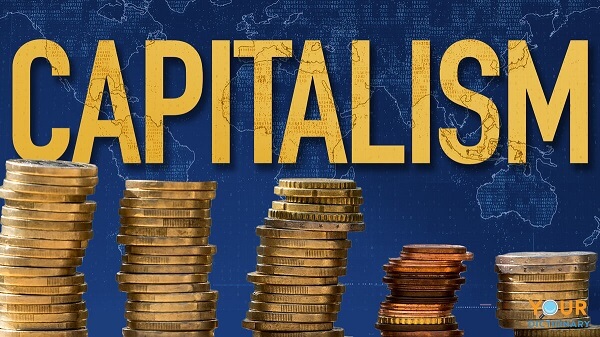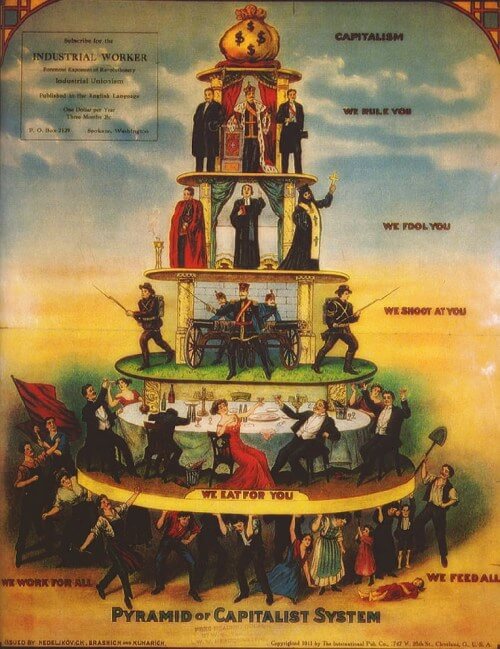Advantages and Disadvantages of CapitalismPrivate companies that own the production inputs are said to operate under capitalism. Entrepreneurs, capital equipment, environmental assets, and labour make up the four components. Companies are used as a means of control by owners of capital assets, raw materials, and businesses. 
Although the method seems straightforward in principle, it's considerably more sophisticated and has both advantages and disadvantages. Here are some details on how capitalism works as well as its benefits and drawbacks. What do you mean by Capitalism?Ownership in a capitalist system entails the management of the production components and a profit-making business model. They are able to run their businesses successfully as a result. Additionally, it gives them the motivation to maximise earnings. The company's owners are indeed the shareholders. The number of shares they possess determines how much power they have. The investors choose a board of trustees, and senior executives are hired to run the business. To function successfully, capitalism needs a free market. The rules of demand and supply are used to distribute products and services. According to the law of supply and demand, a package's price will rise as demand grows. Competition increases output when they see that they can earn more. The more supply drives costs down to a point where only the strongest rivals are left. Note: Growth, profitability, and the opening of new markets are often put above other considerations, like the environment and the well-being of workers.History of CapitalismThe Atlantic Slave Trade, the fledgling industrial network, and colonisation contributed to capitalism's emergence throughout the 16th century and its acceleration during the Industrial Revolution. The system produced riches and status for its owners, but it often did so by taking advantage of individuals with little to no authority, such as industrial employees and native people from Africa and the Americas. 
The emergence of capitalism in 19th-century America was dependent upon the income earned by enslaved people working on land that had been stolen from Native Americans. The Foundation of CapitalismThe following principles form the basis of capitalism:
In mixed economies, so named for the combination of markets & government, markets dominate, but government regulation is more pronounced to address market failures like pollution and traffic congestion, advance social welfare, and for other purposes, including defence and public safety. Today, mixed capitalist economies are the standard. Forms of CapitalismCapitalism is divided into multiple groupings by economists based on a variety of characteristics. As an illustration, capitalism may easily be divided into two sorts depending on how manufacturing is set up. Liberal market economies have a competitive industry that predominates, and most of the manufacturing process is distributed, similar to unrestricted capitalism in the US and the UK. Conversely, coordinating market economies-like those in Germany and Japan-exchange private information via non-market organisations like unions and industry groups (Hall and Soskice, 2001). In recent years, economists have separated four forms of capitalism based on the institutional framework in which new ideas are implemented to promote economic development and the contribution of entrepreneurship (the act of founding enterprises) to innovation ( Litan, Baumol and Schramm, 2007). The government has chosen which industries will expand in state-directed capitalism. This kind of capitalism, initially driven by a desire to promote expansion, has several drawbacks, including excessive investment, choosing the wrong winners, being vulnerable to corruption, and difficulties removing assistance when it is no longer necessary. Oligarchic capitalism is focused on safeguarding and enhancing a relatively small population segment. Since economic development is not a primary goal, inequality and corruption are widespread in these nations. Capitalism based on large corporations benefits from economies of scale. This kind is crucial for the large manufacture of goods. Innovations like the car, phone, and computer are the result of entrepreneurial capitalism. Most of the time, new businesses and people are responsible for these advancements. To widespread and promote innovative items, however, huge businesses are required; hence, a blend of giant enterprises and entrepreneurial capitalism looks ideal. The USA is characterised by this more than any other nation. Advantages of Capitalism1. Choices for customers are made possible by capitalism. Consumers may pick and select what they wish to consume under the capitalist system. The private industry experiences rivalry to offer the finest products or services due to the accessibility of options. Because most people will purchase the greatest product they can afford, thanks to this advantage, innovation levels are raised. 2. The economy is more economically efficient. Capitalism is centered on the production of commodities and services in response to the level of customer demand for the thing or service. Because they are aware of what is required, at a quality standard, and with a set inventory quantity in mind, a corporation may save expenses thanks to this advantage. It makes it possible to develop new incentives that might reduce spending, enabling consumers to consider pricing as a competitive aspect. 3. Capitalism promotes economic expansion. When capitalism prevails in the economy, GDP rises due to increasing demand for innovations, which in turn stimulates more spending. When a consumer's life is improved due to the goods or services they have bought, they can gradually raise their quality of living. The gains from the private companies may be reinvested directly into the system to benefit everyone throughout each cycle since it can employ economic resources more effectively than the governmental sector. Over time, this attribute leads to growth, more employment, and finally greater riches. Socialism doesn't provide this benefit. 4. The capitalist strategy acts as an organic link to equality. The fact that every member of society has an equal chance to become wealthy is what makes capitalism unique. Everyone starts life with the same starting position, even though some individuals may not be able to accomplish their goals for several reasons. Each individual must decide how to approach the concept of innovation. 5. In contrast to socialism, capitalism lets the market determine pricing. Capitalism emphasises services and products on individual needs rather than letting the government intervene with product prices and availability. The demand for a certain good or service determines how much something should be priced in the economy. Depending on how quickly a response is required, inventories are raised or lowered. Because of this, capitalism enables people to choose the goods they think they need to address any issue best. Disadvantages of Capitalism1. Inequality is a long-term consequence of capitalism. Capitalism was founded on the idea that everyone has the right to pass on their riches to the subsequent generation. If a limited number of families control the bulk of the wealth in an economy, they may pass it on to their offspring and preserve the value for future generations. Due to this disadvantage, the wealthy tend to amass wealth over time, whereas the poor remain confronted with financial hardship. Money is given the same power as creativity, initiative, and management. When you have enough, you can buy everything you need to keep your power. 2. Might have an impact on environmental costs Externalities like pollution are often disregarded until they pose a significant threat towards the economy since the market is profit- and demand-driven. As a result, it becomes necessary to lower the amount of money in the economy in order to address these problems. 3. The possibility of industrial disturbance There is frequently a struggle for dominance between business owners, who want to pay their employees less in wage and salary to maximize their profitability, and workers, who think that wages should be raised to reflect the labour they put into creating products and services. This power struggle causes industrial discontent that may threaten the social order. 4. The possibility of exploiting and undervaluing labour These opposers of capitalism include socialists and communists. They claim it harms employees because companies gain more money from sales than they do from paying the people who manufacture the products. Business owners accumulate wealth while people are oppressed and impoverished (taken advantage of). Additionally, they contend that cooperation among individuals for the benefit of society would increase efficiency if individuals focused more on this goal than on competing with one another for their interests. 5. A small group of individuals may own the capital. The fact that power and money are centralized in the hands of a small group of people is one of the drawbacks of capitalism. Wealthy families in society are always in charge of their money. As reported by the New York Times, the wealthiest 1% of the country's population possess over 38% of all privately held assets in the United States of America, the world's capitalist bastion. However, 90percent of the population in the United States is in debt, representing 73% of all debt. ConclusionThe capitalist mode of production has undergone many development phases since the advent of capitalism. Economic crises have gone through stages that called for implementing various economic policies that prioritized the incapability of capital creation. Similar economic strategies controlled both global capitalisms as well as capitalism in various areas of the globe, and they were reflected in increases and dips in average profit rates at the worldwide level at the national level. With each obstacle it overcame, capitalism's method of production thus became more globalized, and national economic plans began to resemble the global rule of money. |
 For Videos Join Our Youtube Channel: Join Now
For Videos Join Our Youtube Channel: Join Now
Feedback
- Send your Feedback to [email protected]
Help Others, Please Share










